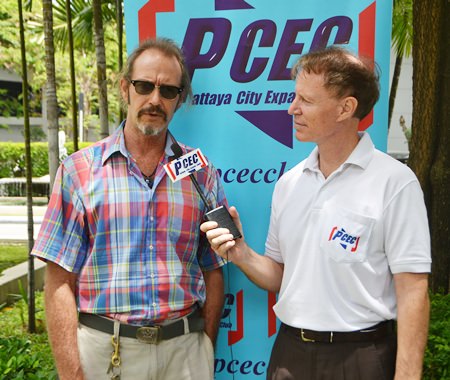Pat Koester waited only 49 years before going back to Thailand’s Kanchanaburi Province, site of the historic bridge that inspired the film “The Bridge on the River Kwai.” Pat visited there in 1967 during her two-year service as a Peace Corps Volunteer. She returned last month with 24 other expats to visit the site and other tourist attractions. Pat and several of the participants shared their experiences with Pattaya City Expats Club at their Sunday, March 13 meeting.
During the presentation, the audience was shown a video (prepared by Member Brian Songhurst) in which images that were taken during their excursion last month were interspersed with slides and movies taken by Pat with a Super 8 camera in 1967.
 PCEC Member Pat Koester begins the presentation on the recent excursion to the Bridge on the River Kwai and other sights in Kanchanaburi Province.
PCEC Member Pat Koester begins the presentation on the recent excursion to the Bridge on the River Kwai and other sights in Kanchanaburi Province.
Several members of the group hiked through Hellfire Pass, one section of the Burma Railway in Thailand which was built with forced labour during the Second World War, in part by Allied prisoners of war. The pass is noted for the harsh conditions and heavy loss of life suffered by its labourers during construction. Hellfire Pass is so named because the sight of emaciated prisoners labouring at night by torchlight was said to resemble a scene from Hell.
Several bridges were used in the construction of the railway. One of them formed the basis of a largely fictional novel and movie (both called The Bridge on the River Kwai). It was a bridge over the Mae Klong River (not the River Kwai) – renamed the Khwae Yai River in the 1960s – at a place called Tha Ma Kham, five kilometers from the town of Kanchanaburi.
 Member Mag Rittinghaus describes how 100,000 allied prisoners died as a result of their forced labor to construct the Thailand-Burma railway for their Japanese captors. Mag, an avid trekker, was the only member of the group to climb all the way to the 7th level on their stop at Erawan Falls.
Member Mag Rittinghaus describes how 100,000 allied prisoners died as a result of their forced labor to construct the Thailand-Burma railway for their Japanese captors. Mag, an avid trekker, was the only member of the group to climb all the way to the 7th level on their stop at Erawan Falls.
Mag Rittinghaus, one of the presenters, said that 100,000 prisoners of war died in forced labour camps – mostly Dutch, British, Australian, and American. Pat mentioned that at Hellfire Pass, there is a museum that tells the whole story. The group visited the Kanchanaburi War Cemetery, where 7,000 prisoners are buried. Pat said that one of the tour participants found the trip especially meaningful as his grandfather was one of the prisoners working in Hellfire Pass.
 PCEC Member Victoria Kudriavtseva describes the Shinto Shrine (Lat Ya Shinto Peace Park provided by a Japanese interest group) and mentions that it was provided as a way of saying “we are sorry.”
PCEC Member Victoria Kudriavtseva describes the Shinto Shrine (Lat Ya Shinto Peace Park provided by a Japanese interest group) and mentions that it was provided as a way of saying “we are sorry.”
Victoria talked about some of the other sites included in the tour. One of them was the Shinto Shrine. Victoria said that there were 12,000 Japanese in this part of Thailand during the war. She explained that conditions were harsh for everyone, and that 1,000 of the Japanese died there. Victoria said that at the end of the war 150 Japanese were sentenced to death as war criminals. Further, that some of the occupying Japanese army stayed behind to help the Americans and British find the war graces of their respective servicemen that died constructing the railway. Victoria explained that the shrine was a way for the Japanese to say, “We are sorry.”
The group also visited the Prommitr Film Studio, built in 2003 for an ambitious film project about King Naresuan by a famous Thai director. They also took a train and boat ride downriver from the famous bridge.
 Member Ren Lexander interviews Pat Koester about her and other members’ presentation on the 3 day tour to Kanchanaburi Province. View the video at https://www.youtube.com/watch?v=wgVLXbtLo0I.
Member Ren Lexander interviews Pat Koester about her and other members’ presentation on the 3 day tour to Kanchanaburi Province. View the video at https://www.youtube.com/watch?v=wgVLXbtLo0I.
Finally, participants visited the Erawan Waterfall and National Park located near the Burmese border. One can climb to the top of the waterfall. There are seven tiers in all. The first five are relatively easy, but for the last two mountaineering skills are required. Mag was the only one in the group to make it all the way to the top.
 Members (left to right) Pat Koester, Victoria Kudriavtseva, Anne Smith, Brian Songhurst, and Mag Rittinghaus with their PCEC Certificate of Appreciation for sharing with their fellow members and guests their experiences on the trip to Kanchanaburi Province.
Members (left to right) Pat Koester, Victoria Kudriavtseva, Anne Smith, Brian Songhurst, and Mag Rittinghaus with their PCEC Certificate of Appreciation for sharing with their fellow members and guests their experiences on the trip to Kanchanaburi Province.
After the presentation, MC Roy Albiston brought everyone up to date on Club and other events and called on Ira Wettenstein to conduct the Open Forum, where questions are asked and answered about Expat living in Thailand, especially Pattaya.
For more information on the PCEC’s many activities, visit their website at www.pcecclub.org.




